A New Sensor System for Accurate 3D Surface Measurements and Modeling of Underwater Objects
Abstract
:Featured Application
Abstract
1. Introduction
2. Materials and Methods
2.1. New Sensor System
2.1.1. Hardware Setup
- Two monochrome measurement cameras arranged in a stereo setup for 3D data acquisition;
- A projection unit producing structured illumination patterns;
- A color camera for navigation and additional visual odometry data capture;
- Two high-power LED flash units, providing synchronized homogenous illumination for the color camera;
- A fiberoptic gyro (FOG) inertial measurement unit (IMU) for motion estimation to support global reconstruction tasks using SLAM algorithms;
- Underwater housings for each camera and the projection unit (IMU is in the housing of the color camera);
- An electronic control and interface box.
2.1.2. 3D Data Generation
2.1.3. Geometric Modeling
2.1.4. Sensor Calibration
- The 3D scanning unit, consisting of two monochrome measurement cameras arranged in a stereo array;
- The color camera (to be calibrated with respect to one of the stereo cameras);
- The IMU (to be calibrated with respect to the color camera).
2.2. Data Recording in Movement
2.2.1. Effects of Sensor Movement on Measurement Data
2.2.2. Motion Compensation
2.2.3. Motion Velocity and Direction Estimation
2.3. 3D Model Generation
3. Experiments and Results
3.1. Evaluation Measurements with Static Sensor
3.2. Measurements with Moved Sensor
3.3. Measurement Example of 3D Model Generation by Registration of Consecutive Scans
4. Discussion
Author Contributions
Funding
Institutional Review Board Statement
Informed Consent Statement
Data Availability Statement
Acknowledgments
Conflicts of Interest
References
- Tetlow, S.; Allwood, R.L. The use of a laser stripe illuminator for enhanced underwater viewing. In Proceedings of the Ocean Optics XII 1994, Bergen, Norway, 26 October 1994; Volume 2258, pp. 547–555. [Google Scholar]
- McLeod, D.; Jacobson, J.; Hardy, M.; Embry, C. Autonomous inspection using an underwater 3D LiDAR. In An Ocean in Common, Proceedings of the 2013 OCEANS, San Diego, CA, USA, 23–27 September 2013; IEEE: New York, NY, USA, 2014. [Google Scholar]
- Canciani, M.; Gambogi, P.; Romano, F.G.; Cannata, G.; Drap, P. Low cost digital photogrammetry for underwater archaeological site survey and artifact insertion. The case study of the Dolia wreck in secche della Meloria-Livorno-Italia. Int. Arch. Photogramm. Remote Sens. Spat. Inf. Sci. 2003, 34, 95–100. [Google Scholar]
- Roman, C.; Inglis, G.; Rutter, J. Application of structured light imaging for high resolution mapping of underwater archaeological sites. In Proceedings of the Oceans’10 IEEE Sydney, Sydney, NSW, Australia, 24–27 May 2010; pp. 1–9. [Google Scholar]
- Drap, P. Underwater photogrammetry for archaeology. In Special Applications of Photogrammetry; Da Silva, D.C., Ed.; InTech: London, UK, 2012; pp. 111–136. ISBN 978-953-51-0548-0. [Google Scholar]
- Eric, M.; Kovacic, R.; Berginc, G.; Pugelj, M.; Stopinsek, Z.; Solina, F. The impact of the latest 3D technologies on the documentation of underwater heritage sites. In Proceedings of the IEEE Digital Heritage International Congress 2013, Marseille, France, 28 October–1 November 2013; Volume 2, pp. 281–288. [Google Scholar]
- Menna, F.; Agrafiotis, P.; Georopoulos, A. State of the art and applications in archaeological underwater 3D recording and mapping. J. Cult. Herit. 2018, 33, 231–248. [Google Scholar] [CrossRef]
- Korduan, P.; Förster, T.; Obst, R. Unterwasser-Photogrammetrie zur 3D-Rekonstruktion des Schiffswracks “Darßer Kogge”. Photogramm. Fernerkund. Geoinf. 2003, 5, 373–381. [Google Scholar]
- Bythell, J.C.; Pan, P.; Lee, J. Three-dimensional morphometric measurements of reef corals using underwater photogrammetry techniques. Coral Reefs 2001, 20, 193–199. [Google Scholar]
- Harvey, E.; Cappo, M.; Shortis, M.; Robson, S.; Buchanan, J.; Speare, P. The accuracy and precision of underwater measurements of length and maximum body depth of southern bluefin tuna (Thunnus maccoyii) with a stereo–video camera system. Fish. Res. 2003, 63, 315–326. [Google Scholar] [CrossRef]
- Dunbrack, R.L. In situ measurement of fish body length using perspective-based remote stereo-video. Fish. Res. 2006, 82, 327–331. [Google Scholar] [CrossRef]
- Costa, C.; Loy, A.; Cataudella, S.; Davis, D.; Scardi, M. Extracting fish size using dual underwater cameras. Aquac. Eng. 2006, 35, 218–227. [Google Scholar] [CrossRef]
- Galceran, E.; Campos, R.; Palomeras, N.; Carreras, M.; Ridao, P. Coverage path planning with realtime replanning for inspection of 3D underwater structures. In Proceedings of the IEEE International Conference on Robotics and Automation, Hong Kong, China, 31 May–7 June 2014; pp. 6585–6590. [Google Scholar]
- Davis, A.; Lugsdin, A. Highspeed underwater inspection for port and harbour security using Coda Echoscope 3D sonar. In Proceedings of the Oceans 2005 MTS/IEEE, Washington, DC, USA, 17–23 September 2005. [Google Scholar] [CrossRef]
- Guerneve, T.; Pettilot, Y. Underwater 3D Reconstruction Using BlueView Imaging Sonar; IEEE: New York, NY, USA, 2015. [Google Scholar] [CrossRef]
- ARIS-Sonars. 2022. Available online: http://soundmetrics.com/Products/ARIS-Sonars (accessed on 17 March 2022).
- Mariani, P.; Quincoces, I.; Haugholt, K.H.; Chardard, Y.; Visser, A.W.; Yates, C.; Piccinno, G.; Risholm, P.; Thielemann, J.T. Range gated imaging system for underwater monitoring in ocean environment. Sustainability 2019, 11, 162. [Google Scholar] [CrossRef] [Green Version]
- 3DatDepth. 2022. Available online: http://www.3datdepth.com/ (accessed on 17 March 2022).
- Moore, K.D. Intercalibration method for underwater three-dimensional mapping laser line scan systems. Appl. Opt. 2001, 40, 5991–6004. [Google Scholar] [CrossRef] [PubMed]
- Tan, C.S.; Seet, G.; Sluzek, A.; He, D.M. A novel application of range-gated underwater laser imaging system (ULIS) in near-target turbid medium. Opt. Lasers Eng. 2005, 43, 995–1009. [Google Scholar] [CrossRef]
- Duda, A.; Schwendner, J.; Gaudig, C. SRSL: Monocular self-referenced line structured light. In Proceedings of the 2015 IEEE/RSJ International Conference on Intelligent Robots and Systems (IROS), Hamburg, Germany, 28 September–2 October 2015; pp. 717–722. [Google Scholar]
- Bleier, M.; van der Lucht, J.; Nüchter, A. Towards an underwater 3D laser scanning system for mobile mapping. In Proceedings of the IEEE ICRA Workshop on Underwater Robotic Perception (ICRAURP’19), Montreal, QC, Canada, 24 May 2019. [Google Scholar]
- CathXOcean. 2022. Available online: https://cathxocean.com/ (accessed on 17 March 2022).
- Voyis. 2022. Available online: https://voyis.com/ (accessed on 17 March 2022).
- Kwon, Y.H.; Casebolt, J. Effects of light refraction on the accuracy of camera calibration and reconstruction in underwater motion analysis. Sports Biomech. 2006, 5, 315–340. [Google Scholar] [CrossRef]
- Telem, G.; Filin, S. Photogrammetric modeling of underwater environments. ISPRS J. Photogramm. Remote Sens. 2010, 65, 433–444. [Google Scholar] [CrossRef]
- Sedlazeck, A.; Koch, R. Perspective and non-perspective camera models in underwater imaging—Overview and error analysis. In Theoretical Foundations of Computer Vision; Springer: Berlin/Heidelberg, Germany, 2011; Volume 7474, pp. 212–242. [Google Scholar]
- Li, R.; Tao, C.; Curran, T.; Smith, R. Digital underwater photogrammetric system for large scale underwater spatial information acquisition. Mar. Geod. 1996, 20, 163–173. [Google Scholar] [CrossRef]
- Maas, H.G. On the accuracy potential in underwater/multimedia photogrammetry. Sensors 2015, 15, 1814–1852. [Google Scholar] [CrossRef]
- Beall, C.; Lawrence, B.J.; Ila, V.; Dellaert, F. 3D reconstruction of underwater structures. In Proceedings of the 2010 IEEE/RSJ International Conference on Intelligent Robots and Systems, Taipei, Taiwan, 18–22 October 2010; pp. 4418–4423. [Google Scholar]
- Skinner, K.A.; Johnson-Roberson, M. Towards real-time underwater 3D reconstruction with plenoptic cameras. In Proceedings of the IEEE/RSJ International Conference on Intelligent Robots and Systems (IROS), Daejon, Korea, 9–14 October 2016; pp. 2014–2021. [Google Scholar]
- Bruno, F.; Bianco, G.; Muzzupappa, M.; Barone, S.; Razionale, A.V. Experimentation of structured light and stereo vision for underwater 3D reconstruction. ISPRS J. Photogramm. Remote Sens. 2011, 66, 508–518. [Google Scholar] [CrossRef]
- Bianco, G.; Gallo, A.; Bruno, F.; Muzzupappa, M. A comparative analysis between active and passive techniques for underwater 3D reconstruction of close-range objects. Sensors 2013, 13, 11007–11031. [Google Scholar] [CrossRef] [PubMed]
- Bräuer-Burchardt, C.; Heinze, M.; Schmidt, I.; Kühmstedt, P.; Notni, G. Underwater 3D surface measurement using fringe projection based scanning devices. Sensors 2016, 16, 13. [Google Scholar] [CrossRef]
- Lam, T.F.; Blum, H.; Siegwart, R.; Gawel, A. SL sensor: An open-source, ROS-based, real-time structured light sensor for high accuracy construction robotic applications. arXiv 2022, arXiv:2201.09025v1. in print. [Google Scholar]
- Furukawa, R.; Sagawa, R.; Kawasaki, H. Depth estimation using structured light flow-analysis of projected pattern flow on an object’s surface. In Proceedings of the IEEE International Conference on Computer Vision, Venice, Italy, 22–29 October 2017; pp. 4640–4648. [Google Scholar]
- Catalucci, S.; Marsili, R.; Moretti, M.; Rossi, G. Point cloud processing techniques and image analysis comparisons for boat shapes measurements. Acta IMEKO 2018, 7, 39–44. [Google Scholar] [CrossRef]
- Gaglianone, G.; Crognale, J.; Esposito, C. Investigating submerged morphologies by means of the low-budget “GeoDive” method (high resolution for detailed 3D reconstruction and related measurements). Acta IMEKO 2018, 7, 50–59. [Google Scholar] [CrossRef]
- Leccese, F. Editorial to selected papers from the 1st IMEKO TC19 Workshop on Metrology for the Sea. Acta IMEKO 2018, 7, 1–2. [Google Scholar] [CrossRef]
- Heist, S.; Dietrich, P.; Landmann, M.; Kühmstedt, P.; Notni, G. High-speed 3D shape measurement by GOBO projection of aperiodic sinusoidal fringes: A performance analysis. In Proceedings of the SPIE Dimensional Optical Metrology and Inspection for Practical Applications VII, Orlando, FL, USA, 17–19 April 2018; Volume 10667, p. 106670A. [Google Scholar] [CrossRef]
- Luhmann, T.; Robson, S.; Kyle, S.; Harley, I. Close Range Photogrammetry; Wiley Whittles Publishing: Caithness, UK, 2006. [Google Scholar]
- Bräuer-Burchardt, C.; Munkelt, C.; Gebhart, I.; Heinze, M.; Heist, S.; Kühmstedt, P.; Notni, G. A-priori calibration of a structured light projection based underwater 3D scanner. J. Mar. Sci. Eng. 2020, 8, 635. [Google Scholar] [CrossRef]
- Bräuer-Burchardt, C.; Munkelt, C.; Gebhart, I.; Heinze, M.; Kühmstedt, P.; Notni, G. Underwater 3D Measurements with Advanced Camera Modelling. PFG-J. Photogramm. Remote Sens. Geoinf. Sci. 2022, 90, 55–67. [Google Scholar] [CrossRef]
- Garrido-Jurado, S.; Muñoz-Salinas, R.; Madrid-Cuevas, F.J.; Marín-Jiménez, M.J. Automatic generation and detection of highly reliable fiducial markers under occlusion. Pattern Recognit. 2014, 47, 2280–2292. [Google Scholar] [CrossRef]
- Kruck, E. BINGO: Ein Bündelprogramm zur Simultanausgleichung für Ingenieuranwendungen—Möglichkeiten und praktische Ergebnisse. In Proceedings of the ISPRS, Rio de Janeiro, Brazil, 17–29 June 1984. [Google Scholar]
- Furgale, P.; Rehder, J.; Siegwart, R. Unified Temporal and Spatial Calibration for Multi-Sensor Systems. In Proceedings of the IEEE/RSJ International Conference on Intelligent Robots and Systems (IROS), Tokyo, Japan, 3–7 November 2013. [Google Scholar]
- Shortis, M. Camera calibration techniques for accurate measurement underwater. In 3D Recording and Interpretation for Maritime Archaeology; McCarthy, J., Benjamin, J., Winton, T., van Duivenvoorde, W., Eds.; Springer: Cham, Switzerland, 2019; Volume 31. [Google Scholar]
- Qin, T.; Li, P.; Shen, S. VINS-Mono: A robust and versatile monocular visual-inertial state estimator. IEEE Trans. Robot. 2018, 34, 1004–1020. [Google Scholar] [CrossRef] [Green Version]
- Bleier, M.; Munkelt, C.; Heinze, M.; Bräuer-Burchardt, C.; Lauterbach, H.A.; Van der Lucht, J.; Nüchter, A. Visuelle Odometrie und SLAM für die Bewegungskompensation und mobile Kartierung mit einem optischen 3D-Unterwassersensor. In Proceedings of the Oldenburger 3D-Tage, 2022. in print. [Google Scholar]
- Elseberg, J.; Borrmann, D.; Nüchter, A. Algorithmic solutions for computing accurate maximum likelihood 3D point clouds from mobile laser scanning plattforms. Remote Sens. 2013, 5, 5871–5906. [Google Scholar] [CrossRef] [Green Version]
- VDI/VDE; VDI/VDE 2634. Optical 3D-Measuring Systems. In VDI/VDE Guidelines; Verein Deutscher Ingenieure: Düsseldorf, Germany, 2008; Parts 1–3. [Google Scholar]
- Bräuer-Burchardt, C.; Kühmstedt, P.; Notni, G. Improvement of measurement accuracy of optical 3D scanners by discrete systematic error estimation. In Combinatorial Image Analysis, Proceedings of the IWCIA 2018, Porto, Portugal, 22–24 November 2018; Barneva, R.P., Brimkov, V., Tavares, J., Eds.; Springer: Cham, Switzerland, 2018; Volume 11255, pp. 202–215. [Google Scholar]
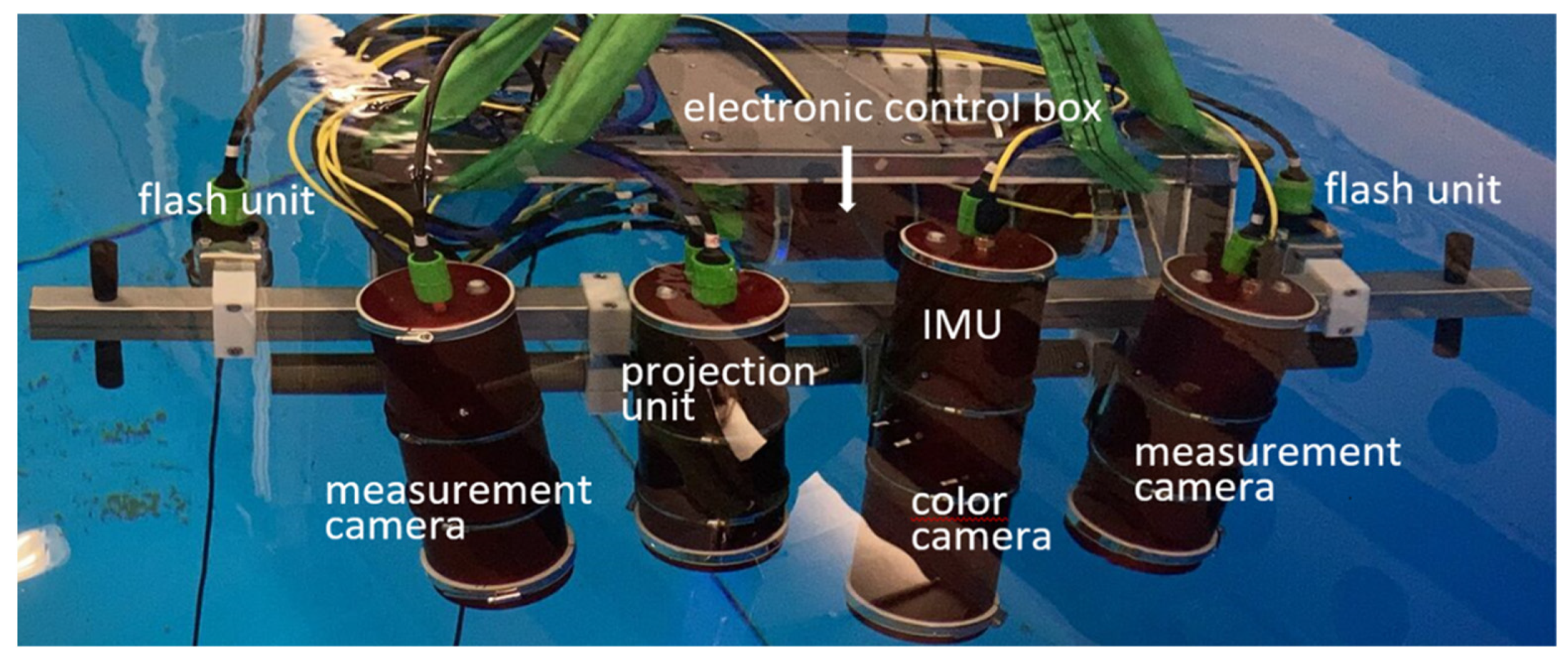
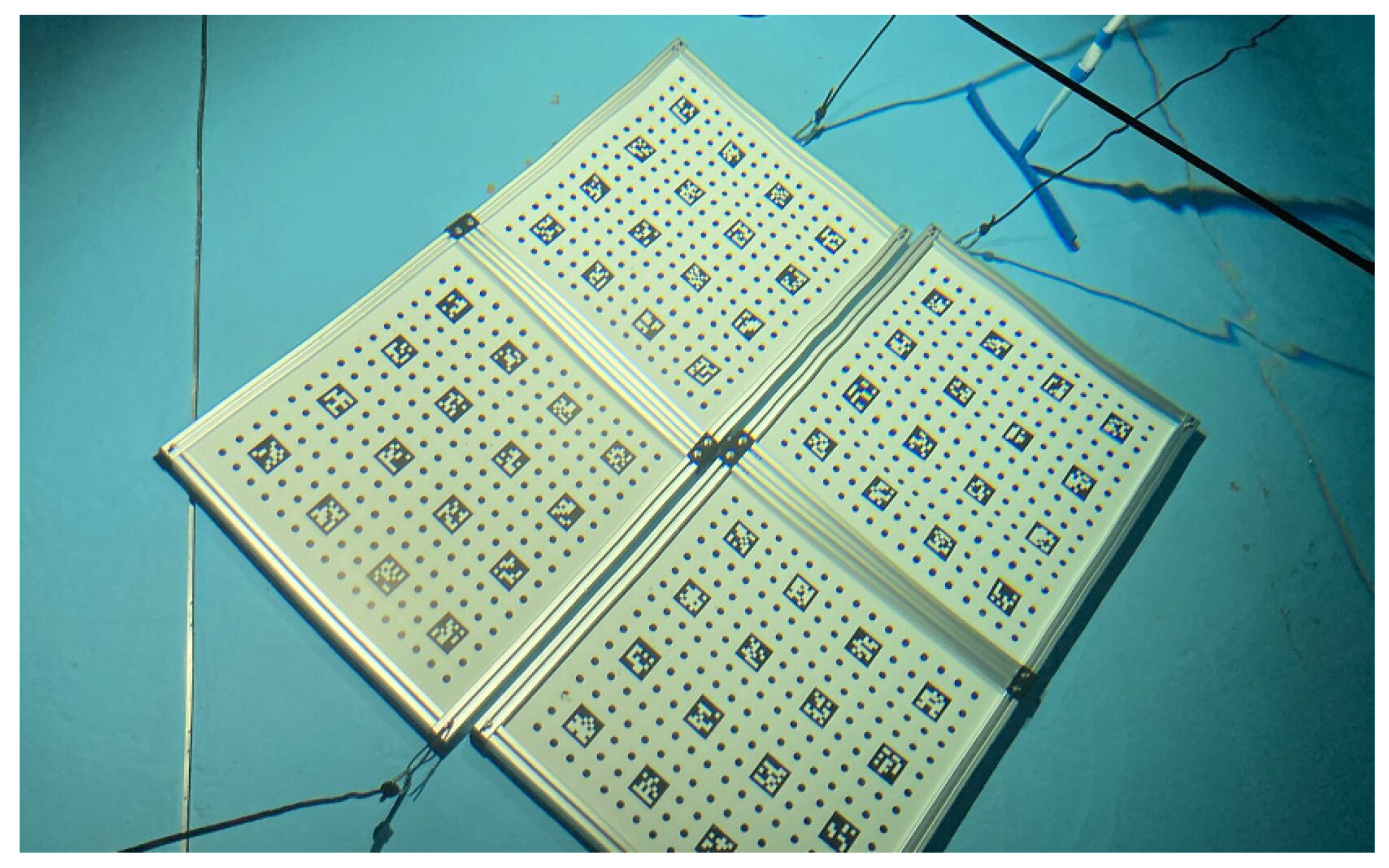
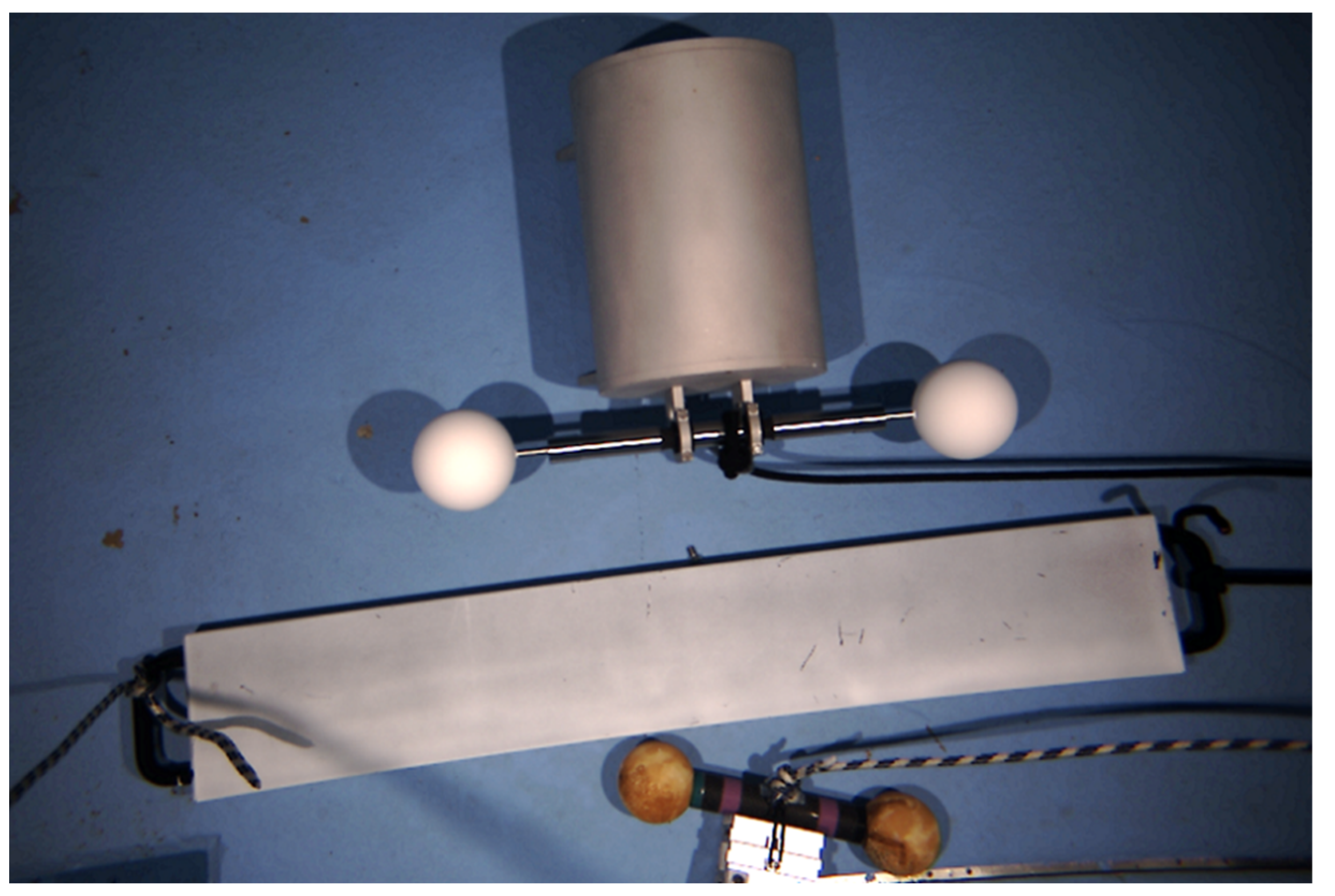
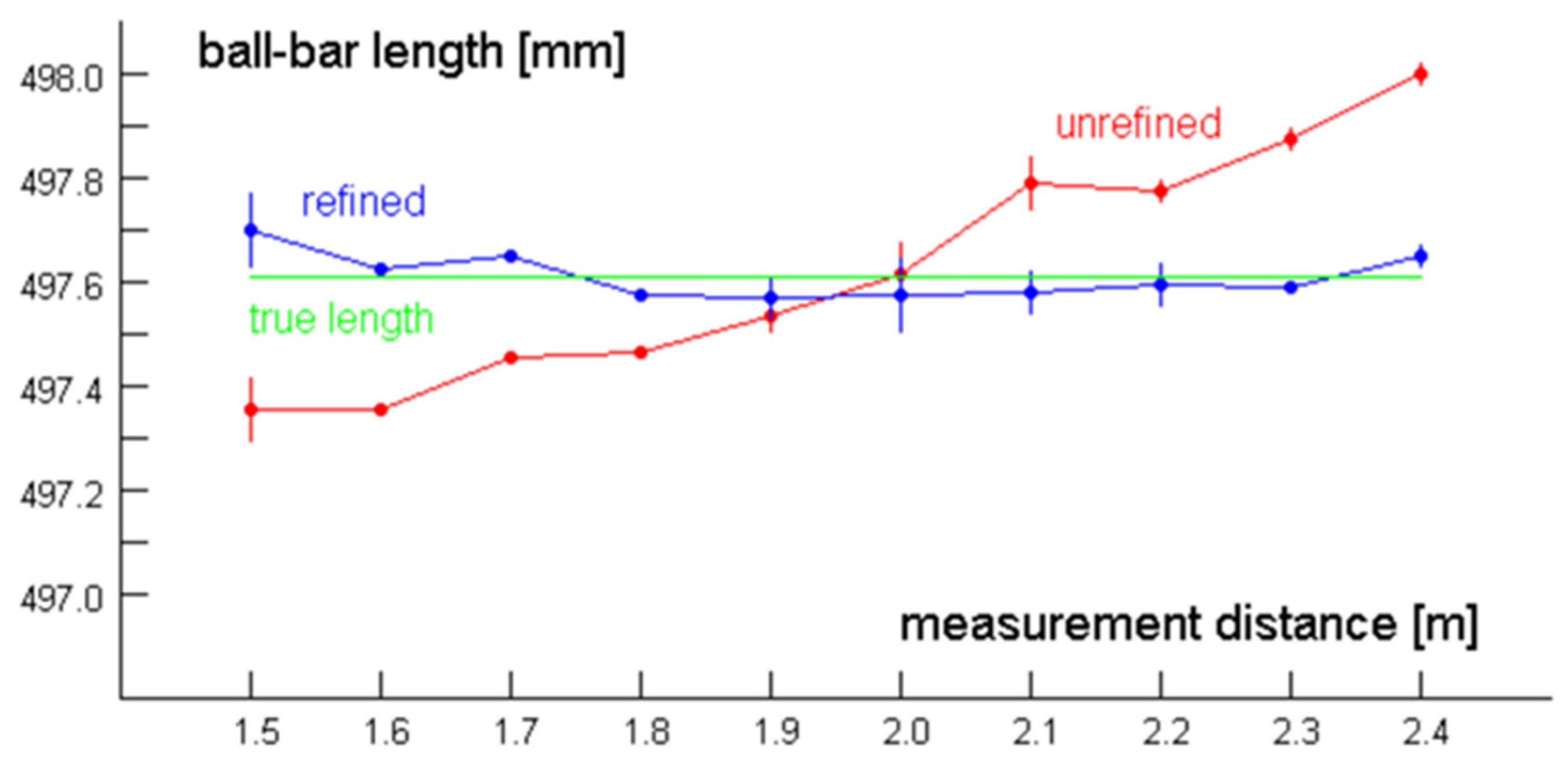
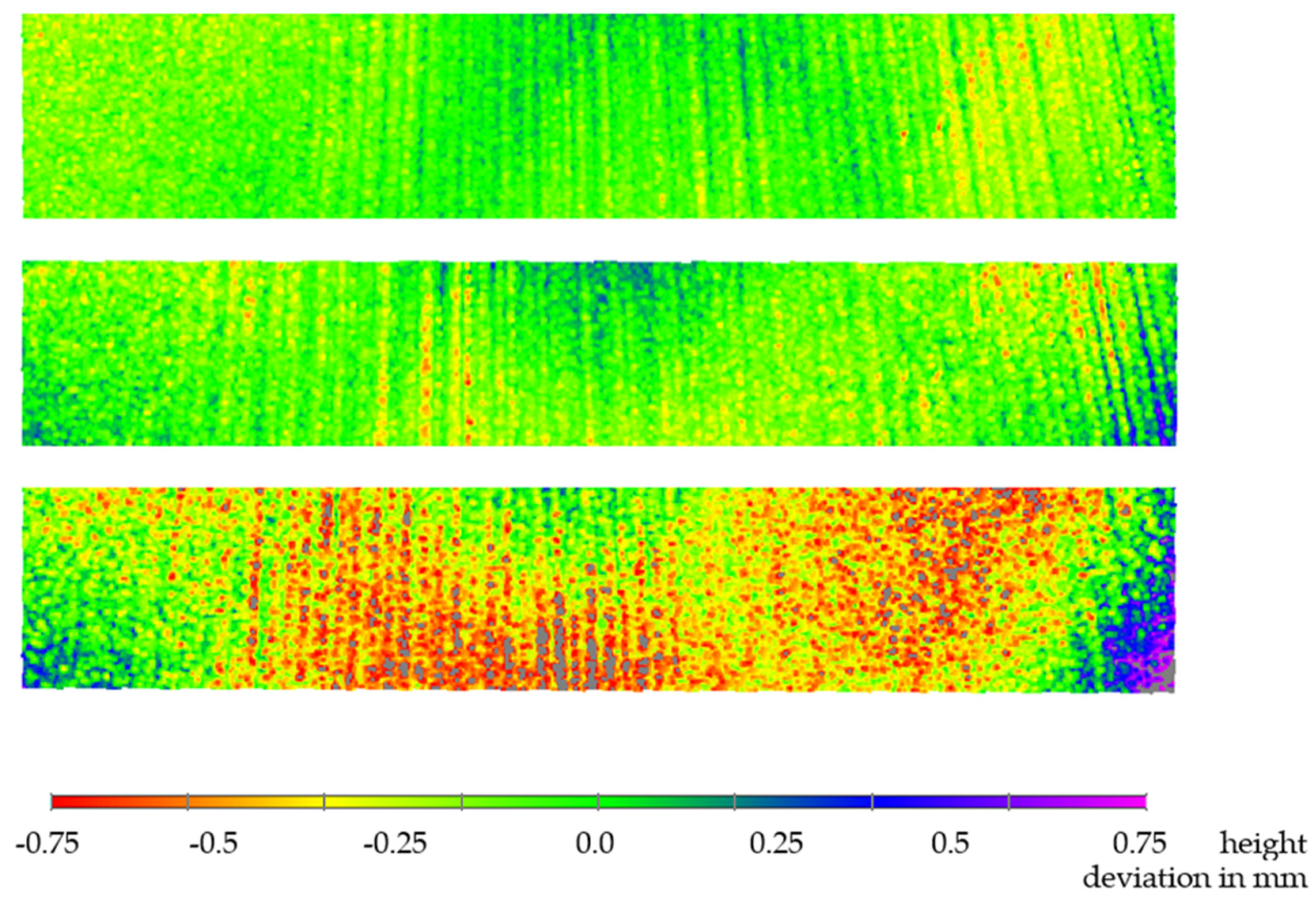
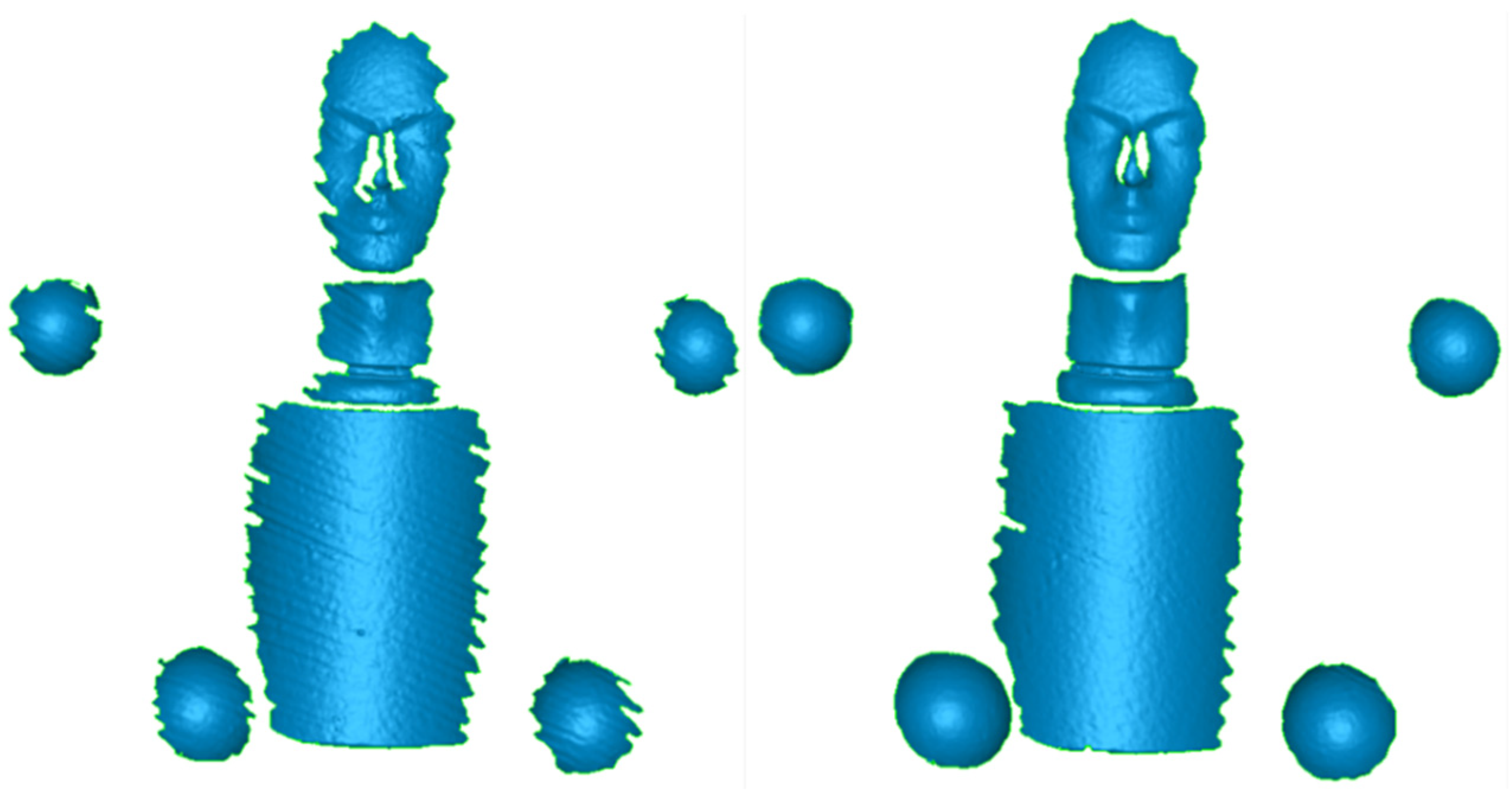

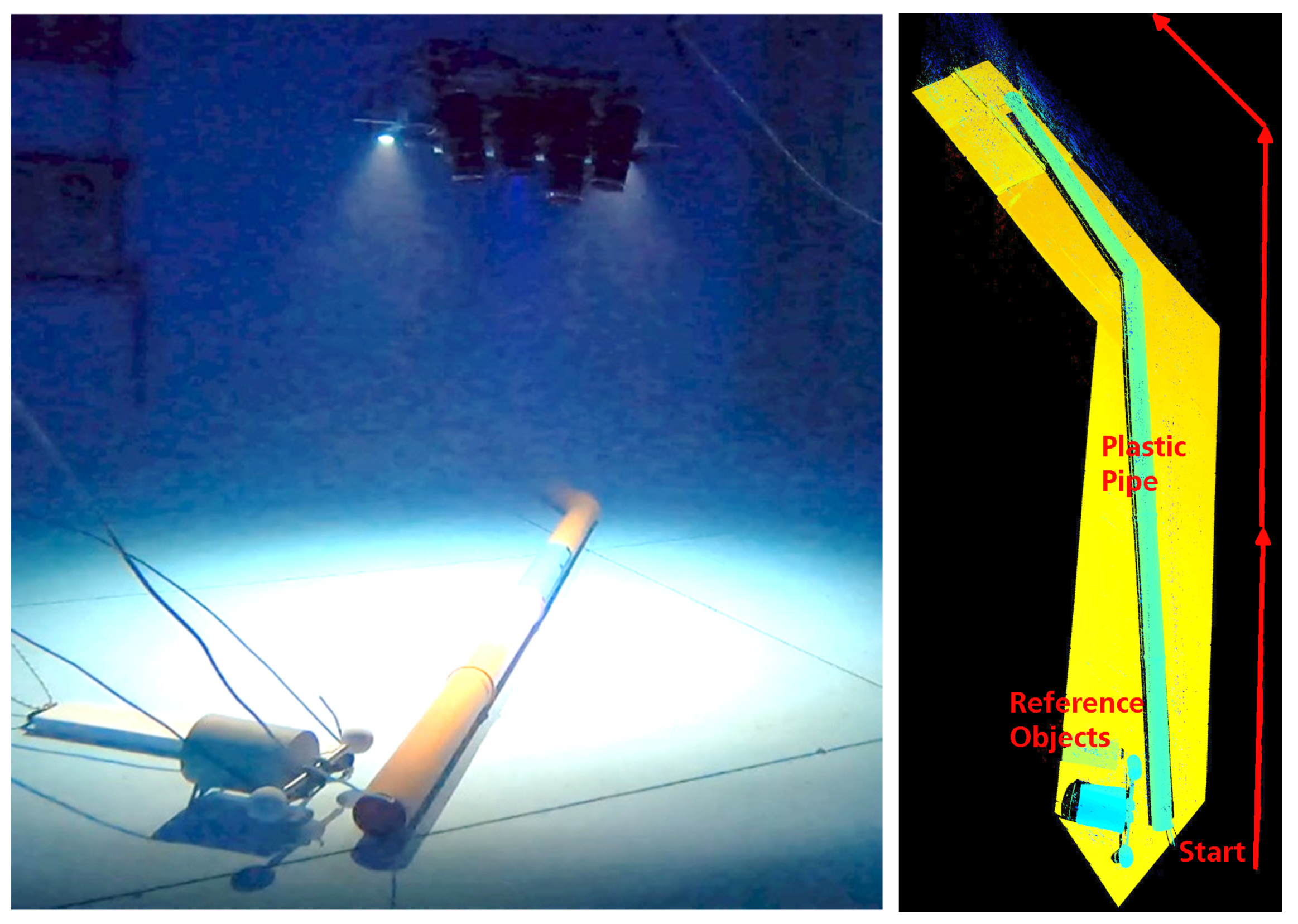
| Distance [m] | R1 [mm] 1 | R1 Refined [mm] 1 | R2 [mm] 1 | R2 Refined [mm] 1 | Length [mm] 1 | Length Refined [mm] 1 |
|---|---|---|---|---|---|---|
| 1.5 | 50.303 ± 0.01 | 50.412 ± 0.07 | 50.174 ± 0.05 | 50.233 ± 0.01 | 497.355 ± 0.06 | 497.702 ± 0.07 |
| 1.6 | 50.360 ± 0.01 | 50.390 ± 0.02 | 50.191 ± 0.03 | 50.239 ± 0.01 | 497.353 ± 0.01 | 497.624 ± 0.01 |
| 1.7 | 50.372 ± 0.01 | 50.444 ± 0.02 | 50.147 ± 0.03 | 50.201 ± 0.04 | 497.457 ± 0.01 | 497.652 ± 0.01 |
| 1.8 | 50.368 ± 0.05 | 50.380 ± 0.01 | 50.193 ± 0.01 | 50.211 ± 0.03 | 497.467 ± 0.01 | 497.574 ± 0.01 |
| 1.9 | 50.361 ± 0.03 | 50.401 ± 0.08 | 50.225 ± 0.01 | 50.234 ± 0.03 | 497.533 ± 0.03 | 497.572 ± 0.04 |
| 2.0 | 50.448 ± 0.01 | 50.445 ± 0.01 | 50.245 ± 0.01 | 50.252 ± 0.02 | 497.614 ± 0.06 | 497.577 ± 0.07 |
| 2.1 | 50.559 ± 0.01 | 50.530 ± 0.01 | 50.225 ± 0.02 | 50.245 ± 0.06 | 497.689 ± 0.05 | 497.578 ± 0.04 |
| 2.2 | 50.515 ± 0.02 | 50.427 ± 0.05 | 50.352 ± 0.01 | 50.286 ± 0.01 | 497.775 ± 0.02 | 497.593 ± 0.04 |
| 2.3 | 50.530 ± 0.03 | 50.504 ± 0.07 | 50.353 ± 0.04 | 50.276 ± 0.05 | 497.874 ± 0.02 | 497.591 ± 0.01 |
| 2.4 | 50.611 ± 0.14 | 50.577 ± 0.04 | 50.425 ± 0.02 | 50.314 ± 0.04 | 498.002 ± 0.02 | 497.648 ± 0.02 |
| average | 50.443 ± 0.11 | 50.451 ± 0.07 | 50.253 ± 0.09 | 50.249 ± 0.04 | 497.612 ± 0.22 | 497.611 ± 0.05 |
| Distance [m] | Noise on Sphere1 [mm] | Noise on Sphere2 [mm] | Noise on Plane [mm] |
|---|---|---|---|
| 1.5 | 0.074 ± 0.01 1 | 0.074 ± 0.01 1 | 0.065 ± 0.02 2 |
| 1.6 | 0.059 ± 0.01 | 0.073 ± 0.02 | 0.075 ± 0.02 |
| 1.7 | 0.062 ± 0.01 | 0.075 ± 0.01 | 0.070 ± 0.01 |
| 1.8 | 0.085 ± 0.01 | 0.081 ± 0.01 | 0.080 ± 0.02 |
| 1.9 | 0.071 ± 0.01 | 0.096 ± 0.01 | 0.090 ± 0.01 |
| 2.0 | 0.078 ± 0.01 | 0.078 ± 0.01 | 0.085 ± 0.01 |
| 2.1 | 0.087 ± 0.01 | 0.089 ± 0.01 | 0.095 ± 0.01 |
| 2.2 | 0.114 ± 0.01 | 0.093 ± 0.01 | 0.115 ± 0.03 |
| 2.3 | 0.098 ± 0.01 | 0.089 ± 0.01 | 0.120 ± 0.02 |
| 2.4 | 0.133 ± 0.01 | 0.104 ± 0.01 | 0.130 ± 0.02 |
| average | 0.086 ± 0.23 | 0.085 ± 0.13 | 0.080 ± 0.13 |
| Velocity | Compensation Method | Standarddev. Sphere-Fit | Point Number on Sphere | Standarddev. Cylinder-Fit | Point Number on Cylinder |
|---|---|---|---|---|---|
| 0.1 m/s | No | 0.39 mm | 6800 | 0.31 mm | 69,000 |
| 0.1 m/s | Manually | 0.31 mm | 7100 | 0.32 mm | 69,000 |
| 0.1 m/s | Automatically | 0.33 mm | 7100 | 0.32 mm | 69,000 |
| 0.7 m/s | No | 0.52 mm | 3200 | 0.39 mm | 47,500 |
| 0.7 m/s | Manually | 0.36 mm | 5200 | 0.34 mm | 49,600 |
| 0.7 m/s | Automatically | 0.32 mm | 6000 | 0.34 mm | 49,600 |
| Device | Measurement Volume | Measurement Distance | Exposure Time |
|---|---|---|---|
| Ref [32] | 0.5 m × 0.4 m × 0.4 m 1 | 1.0 ± 0.20 m | not specified |
| Ref [33] | 0.5 m × 0.4 m × 0.2 m 1 | 1.0 ± 0.10 m | 0.8 … 10 s |
| Ref [34] | 0.25 m × 0.2 m × 0.1 m | 0.4 ± 0.05 m | 15 ms |
| UWS | 0.9 m × 0.8 m × 0.8 m | 2.0 ± 0.40 m | 1 … 2.6 ms |
Publisher’s Note: MDPI stays neutral with regard to jurisdictional claims in published maps and institutional affiliations. |
© 2022 by the authors. Licensee MDPI, Basel, Switzerland. This article is an open access article distributed under the terms and conditions of the Creative Commons Attribution (CC BY) license (https://creativecommons.org/licenses/by/4.0/).
Share and Cite
Bräuer-Burchardt, C.; Munkelt, C.; Bleier, M.; Heinze, M.; Gebhart, I.; Kühmstedt, P.; Notni, G. A New Sensor System for Accurate 3D Surface Measurements and Modeling of Underwater Objects. Appl. Sci. 2022, 12, 4139. https://doi.org/10.3390/app12094139
Bräuer-Burchardt C, Munkelt C, Bleier M, Heinze M, Gebhart I, Kühmstedt P, Notni G. A New Sensor System for Accurate 3D Surface Measurements and Modeling of Underwater Objects. Applied Sciences. 2022; 12(9):4139. https://doi.org/10.3390/app12094139
Chicago/Turabian StyleBräuer-Burchardt, Christian, Christoph Munkelt, Michael Bleier, Matthias Heinze, Ingo Gebhart, Peter Kühmstedt, and Gunther Notni. 2022. "A New Sensor System for Accurate 3D Surface Measurements and Modeling of Underwater Objects" Applied Sciences 12, no. 9: 4139. https://doi.org/10.3390/app12094139





